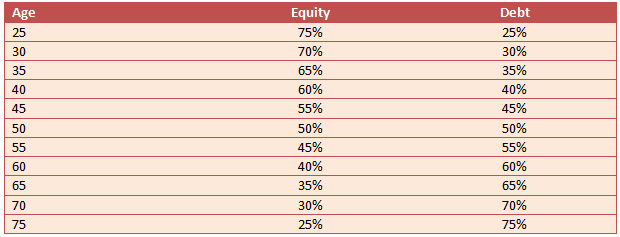Overcoming obstacles through asset allocation for diverse life stages

From childhood to adulthood, to being married, becoming a parent and finally a senior citizen, we go through different stages of life. Your income, priorities and spending habits change depending on which life stage you are in. The priorities of different life stages can be navigated better if you change your investments depending on your life stage. One of the most important aspects of life stage investments is asset allocation.
What is asset allocation?
Asset allocation is spreading your investments over different asset classes (e.g. equity, fixed income, gold, real estate etc). The objective of asset allocation is to diversify your risks by spreading it over different asset classes with different risk profiles:-
- Equity: This refers to shares of listed companies or stocks. Equity as an asset class is volatile, but has the potential of generating superior returns in the long term. The primary investment objective in equity as an asset class is capital appreciation. You can get exposure to equity through mutual funds, which invest in a diversified portfolio of stocks across different industry sectors. You need to have high to very high risk appetites for equity.
- Fixed income: As the name suggests the primary objective of this asset class is to generate income. Bank fixed deposits, Government Small Savings Schemes, bonds, debentures, debtmutual funds which invest in debt and money market instruments are examples of fixed income investments. Fixed income as an asset class has significantly lower volatility compared to equity. It is suitable for investors with low to moderate risk appetites.

Source: NSE, Advisorkhoj Research (as on 29th July 2022). Nifty 50 TRI and Nifty 10 year benchmark G-Sec index has been used as proxies for equity and fixed income as asset classes. Past performance may or may not be sustained in the future.
You can see in the chart above that risk and return are interrelated; higher the risk, higher the potential returns. Asset allocation will optimize risk and returns, and help you achieve your financial goals, irrespective of short term market movements.
Asset allocation in different life-stages
Your income, savings, financial obligations and risk capacity will change depending on different life stages. Accordingly, your asset allocation should change to help you navigate through the challenges in different stages of life. A popular asset allocation rule, Rule of 100, states that the percentage equity allocation in your portfolio should be 100 minus your age. The table below shows the Rule of 100 asset allocation for different ages.

Let us now discuss, six different stages of life an average investor usually goes through, the challenges in different life stages and how investors can overcome it through asset allocation:-
Podcast on asset allocation: https://mutualfund.adityabirlacapital.com/Investor-Education/our-sections/listen/podcast-11
Starting your career, not yet married
This is the stage of life which begins when you start working and typically spans the period from your early 20s to around 30. In this life stage, you may be able to save a sizeable portion of your income depending on your lifestyle. Since you are young and do not have much financial obligations, you can have high risk appetite. You can have 75 – 80% allocation to equities and the balance (20 – 25%) in fixed income. Equity investments made in this life stage can create substantial wealth for your long term financial goals e.g. retirement planning through the power of compounding.
Getting married, no kids
In modern India, it spans the period from your mid / late 20s to early 30s. Your financial responsibilities start increasing during this period, but your income would have increased too; you can still save a fairly substantial portion of your income. Your financial priorities change and you start purchasing assets like vehicle, house etc. You should also continue investing for your long term financial goals e.g. retirement planning. Your equityallocation in this life stage can come down to 70% andyour balance portfolio (30%) should be in fixed income investments for your short to medium term financial goalse.g. buying a vehicle, house etc. You should also have a liquid fund of 3 – 6 months of your expenses to meet contingencies (unforeseen circumstances).
Did you know what is the importance of goal setting in financial planning
Becoming parents, young children
Your responsibilities increases manifoldwith parenthood and so do your expenses e.g. children’s school fees, in addition to your vehicle / home loan EMIs along with other day to day expenses. Nevertheless, you should also start planning for your children’s future i.e. their higher education, marriage etc from a young age. Youshould continue to invest for your long term financial goals like retirement planning. Since your financial obligations are significantly higher now, your risk appetite will be relatively lower. Your asset allocation in equities should now be 60 – 65% and fixed income allocation should be 35 – 40%.
Financial planning for new parents https://mutualfund.adityabirlacapital.com/Investor-Education/our-sections/read/financial-planning-for-new-parents
Children growing up
This is the stage of life between the ages, 40 to 55. Since you have reached the mid stages of your career, your income is much higher and you may have repaid some debts e.g. vehicles loans. This is the time for consolidation. Since timelines of your different life stage goals e.g. children’s higher education are drawing closer, you should rebalance investment portfolio from time to time to ensurethat the approaching life stage goals are not exposed to equity volatility. However, you should continue investing in equity for your long term goals e.g. retirement. In this stage of life a balanced allocation i.e. 50% equity and 50% fixed income may be suitable for you.
Pre-retirement
This is the penultimate stage of life, usually from the age of 55 till the time you retire. By now you would have fulfilled many of your life stage goals and are likely to be debt free as well. Retirement planning should be your most important financial goal. You should rebalance your portfolio so that you do not experience any big drawdown (reduction in portfolio value) due to market volatility. You should reduce your equity exposure to 40 – 45% and increase your fixed income exposure to 55 – 60% as your approach retirement.
You must also read the top 5 retirement planning mistakes that you can avoid
Post retirement
After retirement you will be dependent on the income from your investments to meet all your expenses. Since your risk appetite will be relatively low now, you should allocate a large portion of your portfolio to fixed income. However, you still need to get some capital appreciation from equity because your expenses will keep increasing over time due to inflation. Historical data shows that equity as an asset class can beat inflation over long investment horizons. Post retirement your asset allocation to fixed income should be 70 – 75%, while you can invest 25 – 30% in equities.
Importance of retirement planning https://mutualfund.adityabirlacapital.com/Investor-Education/our-sections/watch/the-importance-of-retirement-planning
Conclusion
In this blog post, we discussed how asset allocation can help you overcome challenges in different life stages. Investors should note that the asset allocations discussed in this post are for general investor education purpose only and not investment recommendations. Your asset allocation should be based on your financial situation, your risk appetite and the specific needs of your family. You should also understand the tax implications of your investments and make informed decisions.
You should consult with a financial advisor if you need help in understanding your risk appetite and optimal asset allocation.
Disclaimer: An Investor education and Awareness initiative of Aditya Birla Sun Life Mutual Fund.
All investors have to go through a one-time KYC (Know Your Customer) process. Investors to invest only with SEBI registered Mutual Funds. For further information on KYC, list of SEBI registered Mutual Funds and redressal of complaints including details about SEBI SCORES portal, visit link : https://mutualfund.adityabirlacapital.com/Investor-Education/education/kyc-and-redressal for further details.
Mutual Fund Investments are subject to market risk, read all scheme related documents carefully.
RECOMMENDED READS
LATEST ARTICLES
- ABSL SIP for Life: Plan to build and enjoy your wealth
- Aditya Birla Sun Life Flexi Cap Fund: Legendary track record of wealth creation
- Aditya Birla Sun Life Large Cap Fund: 23 years track record of outperformance and wealth creation
- Why is SIP Sabse Important Plan
- How can Multi Asset Allocation Funds provide stability in your portfolio
Follow Birla Sun Life MF
More About ABSL MF
POST A QUERY






